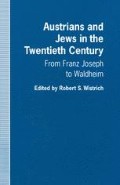Abstract
The last years of the government of Eduard Taafe, following the Young Czech sweep in the 1891 elections to the Austrian Imperial Parliament (Reichsrat) witnessed the beginnings of a general radicalization in the political affairs of the Czech lands. The Young Czech triumph of May 1891 had, in fact, capped a decade of achievement for the liberal wing of the Czech national movement. The expansion of the Czech national school system in the 1870s and 1880s, the language reforms of 1880 and 1886 and the creation of a Czech university in Prague in 1882 had laid the foundations for an important shift in the cultural and political balance of power in the Czech lands of the Habsburg Monarchy.1
Access this chapter
Tax calculation will be finalised at checkout
Purchases are for personal use only
Preview
Unable to display preview. Download preview PDF.
Notes
On the successes of the Czech national movement in the 1880s, see H. Gordon Skilling, ‘The Politics of the Czech Eighties’, in Peter Brock and H. Gordon Skilling (eds)., The Czech Renascence of the Nineteenth Century (Toronto, 1970), pp. 254–81;
Skilling, ‘The Partition of the University in Prague’, Slavonic and East European Review vol. 27 (1949), pp. 430–49;
Bruce M. Garver, The Young Czech Party, 1874–1901, and the Emergence of a Multi-Party System (New Haven, Conn. 1978), pp. 60–153;
Tomáš Vojtĕch, Mladočeší a boj o politickou moc v Cechách (Prague, 1980)
Friedrich Prinz, ‘Die böhmischen Länder von 1848 bis 1914’, in Karl Bosl (ed.), Handbuch der Geschichte der böhmischen Länder, vol. 3 (Stuttgart, 1968), pp. 3–235.
Gary B. Cohen, The Politics of Ethnic Survival: Germans in Prague, 1860–1914 (Princeton, NJ, 1981), pp. 91–100, 145–6.
On the social roots of the Czech Jewish movement, see Hillel J. Kieval, The Making of Czech Jewry: National Conflict and Jewish Society in Bohemia, 1870–1918 (New York and Oxford, 1988), pp. 10–17 and 23–7.
Important demographic information is contained in Jan Heřman, ‘The Evolution of the Jewish Population in Bohemia and Moravia, 1754–1953’, in U.O. Schmelz, P. Glikson and S. Della Pergola (eds), Papers in Jewish Demography, 1973 (Jerusalem, 1977), pp. 255–65
Heřnan, ‘The Evolution of the Jewish Population in Prague, 1869–1939’, in Schmelz, Glikson and Della Pergola (eds.), Papers in Jewish Demography 1977 (Jerusalem, 1980), pp. 53–67.
Františsek Cervinka, Ceský nacionalismus v 19. století (Prague, 1964)
Cervinka, Boje a směry českého studentistva na sklonku minulého a na počátku našého století (Prague, 1962). For a more charitable view of Young Czech attitudes, see Garver, The Young Czech Party, pp. 302–3.
Michael A. Riff, ‘Czech Antisemitism and the Jewish Response before 1914’, Wiener Library Bulletin, vol. 29 (1976), pp. 9–10.
Stanley B. Winters, ‘Kramář, Kaizl, and the Hegemony of the Young Czech Party, 1891–1901’, in Brock and Skilling (eds.), The Czech Renascence, p. 304 (New York, 1950)
also Berthold Sutter, Die Badenischen Sprachverordnungen von 1897: Ihre Genesis und ihre Auswirkungen vornehmlich auf die innerösterreichischen Alpenländer, vol. 1 (Graz and Cologne, 1960), p. 11.
See the discussion in Christoph Stölzl, Kafkas böses Böhmen: Zur Sozialgeschichte eines Prager Juden (Munich, 1975), pp. 61–62.
Sutter, Die Badenischen Sprachverordnungen, vol. 2 (Graz and Cologne, 1965), pp. 231–2; Riff, ‘Czech Antisemitism’, pp. 11–13.
On the German national workers’ associations in northern Bohemia, see Andrew G. Whiteside, Austrian National Socialism before 1918 (The Hague, 1962), pp. 51–87
On Lueger and the Christian Social movement as an anti-Semitic force, see Peter G. J. Pulzer, The Rise of Political Anti-Semitism in Germany and Austria (New York, 1964), pp. 127–88
Carl E. Schorske, ‘Politics in a New Key: An Austrian Trio’, in his Fin-de-Siècle Vienna: Politics and Culture (New York, 1980), pp. 116–80.
Ibid., pp. 160, 181–2. On Jewish fraternal organizations in Bohemia, see Meir Färber, ‘Jewish Lodges and Fraternal Orders Prior to World War II’, in The Jews of Czechoslovakia, vol. 2 (Philadelphia, 1971), pp. 229–42. B’nai B’rith was founded in New York in 1843, but the first European chapter (The Lodge of the German Empire) was not established until 1882 (see Encyclopaedia Judaica, vol. 4, cols 1143–9).
Stuart Borman, ‘The Prague Student Zionist Movement, 1886–1914’ (PhD Dissertation, University of Chicago, 1972), pp. 7–8; Cohen, The Politics of Ethnic Survival, pp. 210–12.
Borman, ‘The Prague Student Zionist Movement’, p. 8; Cohen, The Politics of Ethnic Survival, p. 212. Cohen cites a report that listed the membership of the Lese- und Redehalle for 1891 at 635 and for 1892 at only 334. Ernst Pawel puts the membership of the association during Franz Kafka’s university years (1901–6) at approximately 450, but he does not cite a source for this figure. See Ernst Pawel, The Nightmare of Reason: A Life of Franz Kafka (New York, 1984), p. 106.
Kieval, The Making of Czech Jewry, pp. 60–1. See also Osterreichische Statistik, vol. 63, pt 3 (1902), p. 178; and Bureau of Jewish Statistics, Berlin, Die Juden in Österreich (Berlin, 1908), p. 14. The breakdown for the 1900 census was as follows: For Bohemia as a whole: Czech 50 080 German 40 521 Other 177. For the city of Prague: Czech 9 880 German 8 230
Eduard Lederer, Zid v dnesšní společnosti (Prague, 1902), p. 111.
Dr W., ‘Vor zwanzig Jahren’, Selbstwehr, 8 May 1914, p. 2. See also Ruth Kestenberg-Gladstein, ‘Athalot Bar Kochba’, in Felix Weltsch (ed.), Prag vi-Yerushalayim (Jerusalem, 1954), p. 89.
Editor information
Editors and Affiliations
Copyright information
© 1992 Palgrave Macmillan, a division of Macmillan Publishers Limited
About this chapter
Cite this chapter
Kieval, H.J. (1992). Jews, Czechs and Germans in Bohemia Before 1914. In: Wistrich, R.S. (eds) Austrians and Jews in the Twentieth Century. Palgrave Macmillan, London. https://doi.org/10.1007/978-1-349-22378-7_2
Download citation
DOI: https://doi.org/10.1007/978-1-349-22378-7_2
Publisher Name: Palgrave Macmillan, London
Print ISBN: 978-1-349-22380-0
Online ISBN: 978-1-349-22378-7
eBook Packages: Palgrave History CollectionHistory (R0)

